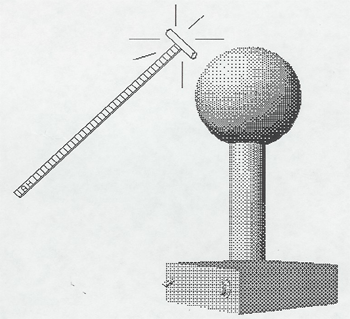- 1. Mechanics
- 2. Harmonic Motion, Waves and Sound
- 3. Matter and Thermodynamics
- 4. Electricity and Magnetism
- 5. Light and Optics
- 6. Modern Physics
- 7. Astronomy
- 8. Software and Multimedia
- 9. Index and code conversion from older manual
- External Resources
50. Electric Potential
The equipotentials of a charged sphere are concentric spheres centered on the charged sphere. A small fluorescent tube is held on a plastic meter stick near the charged Van der Graaff sphere. When the tube is along a radial line of the sphere, the tube lights; the ends are at different potentials. But when the fluorescent tube is held tangent to a concentric sphere, the tube does not light; the ends are at the same potential.
To show that work is done in bringing a charge up close to another charge, alternately touch the grounded discharge rod to the Van der Graaff sphere and move it away. When the sphere is grounded the motor driving the belt runs faster - -more freely. No work is done to bring charge up. But when the grounding rod is moved away, the motor slows down, "lugging" away to carry charge up the belt close to the charge building up on the sphere. The charge carried up on the belt is delivered to the center of the sphere, whence it quickly moves to the outside of the sphere in obedience to Gauss's Law. As the charge on the sphere builds up, it begins to leak into the air. Equilibrium is reached when the charge leaks off the sphere as fast as the belt is able to bring new charge up.


